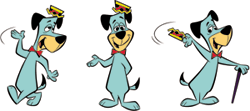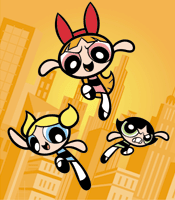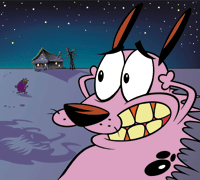While Turner Broadcasting System's Boomerang is titled to draw the Baby Boom generation is seems that maybe they've missed the spot marked X. Martin "Dr. Toon" Goodman explains.
"Don't want to end up a cartoon in a cartoon graveyard... "- Paul Simon ©1986 BMI Music

Memories from a sixth-grade history class: I recall seeing pictures of pale, pitted figurines that resembled malformed gingerbread men iced with dirt. My textbook informed me that these objects were "fertility statues," created to ensure fecund livestock and bountiful crops. At least that was the prevailing theory; they might have actually been the Sumerian equivalent of fuzzy dice, pet rocks or action figures. After some 5,000 years, who really knew? This conjecture led to the only interesting homework assignment I ever had in elementary school: "If archaeologists were to dig up our classroom 5,000 years from now, what assumptions might they make about the artifacts they find?" That was a challenging question in 1965, but answering it in 2001 is simple: They wouldn't need to make any assumptions at all.
Assuming no nuclear conflagrations, environmental disasters, world-cleansing global pandemics or invasions by the Drej, the record of the past should be easy to read. Current technology has been able to preserve civilization through the use of increasingly sophisticated devices, and at least the past fifty years of cultural history are available to all mankind on CD-ROM, DVD and other formats. Frequently this historical record reappears in digitally remastered form, looking and sounding better than ever. This is no sci-fi fancy: source material will be preserved in ways yet unforeseen and it is conceivable that audiences a thousand years from now will be able to view an original episode of Rocky and His Friends with full understanding of the cultural context. Sure, the show may seem a bit weird and unworldly but hardly indecipherable, since it will never have disappeared. These audiences will contain historians and academics, but also fans who will recognize many of the show's nuances.

Old Is New: Boomerang
Which brings us to April 1, 2000 and the premiere of Turner Broadcasting System's newest offering, Boomerang. A companion channel to the highly successful Cartoon Network, Boomerang differed from its "sister" by offering vintage cartoons. The title suggested the "baby boom" generation born between 1946 and 1964 who were ostensibly the original audience for these cartoons, and the fact that the cartoons had returned to their cultural owners and caretakers. Boomerang first cut a deal with EchoStar satellite service and then hit it big with DirecTV soon thereafter. In an interview with ign (March 27, 2000), Cartoon Network president Betty Cohen noted that while, "Cartoon Network's phenomenal audience growth with older kids and younger adults is increasingly driven by our aggressive ramp-up of original programming and contemporary acquisitions...our research and consumer feedback tells us we still have enormous opportunity to serve baby boomer parents with more of the classic favorites they grew up with. Boomerang will give them the chance to share those favorites with their kids."

Noble sentiments indeed. Economical ones as well. Research and consumer feedback have neither ensured success nor averted disaster in the world of TV programming, and the Cartoon Network execs are likely aware of that fact. Boomerang may, in fact, have a secondary and even tertiary purpose. Cartoon Network has two important goals that mitigate against older toons dominating its programming. CN must ensure a steady dose of progressive and original programming. They must also develop the intensive marketing that is inseparable from toons that slip their restrictive time blocks and enter the mainstream's profitable secondary markets. To these ends, Cartoon Network has dedicated its prime viewing hours to original programming. Their phenomenally lucrative Friday evening block (7:30pm-11pm) was a key factor in gaining the economic leverage needed for program expansion. CN is one of (ad-supported) cable TV's highest rated networks, and advertising revenue exploded 40% over 1998-99 levels, partly due to this block's popularity with viewers.

Some original projects, such as Ed, Edd n Eddy, are passable. Other programs like Cow and Chicken or Dexter's Laboratory have a steady following. Still other programs, primarily The Powerpuff Girls, have slipped the leash and are on the eventual way to classic status. Cartoon Network continues to develop its own shows and will do so for the foreseeable future; Cohen and company have made a $350 million commitment to original programming, and at this time there are reportedly 25 animated shorts in sundry stages of development. Each one has the potential to develop into a series within the next two years. Add to that the commitment that CN is making to anime (Gundam Wing and Techni Muyo are now on the scene in addition to CN's other imports), and there is far less time available for Hanna-Barbera leftovers such as Amazing Chan and the Chan Clan.
Wait...Who's Watching What?
Still, how can one let a library spanning forty years of Saturday morning animation lie fallow? Adults make up 35% of CN's viewing audience, and its viewership spends an average of seven hours per week "tooned" in to the station. The average viewer is 81% more likely to have four or more television sets in the home than non-viewers. This suggests that there is certainly enough time, TV sets and adults to go around for the vintage toons, but I find myself puzzled by a couple of other statistics, and these deserve examination since they left me wondering at which audience the Boomerang network is truly aimed.

As noted earlier, Boomers represent people born in the years 1946-1964 (ages 55-37). If we add five years to these birth dates to reflect more accurately the times in their lives when Boomers were first addicted to cartoons, the range of programming would reflect the years 1951-1969. Demographic studies suggest that the typical head of the household among CN's audience is in the 25-34 age range, which suggests birth dates ranging from 1967-1976. If we were to apply the same five-year rule, the range of programming would represent something like 1972-1981. This range more accurately reflects the prevalent programming on Boomerang. In an interview with l.a. life on April 1, 2000, Boomerang senior VP Mark Norman suggested that the network would be concentrating on the years between 1963 and 1976. If the viewership of Boomerang, as Ms. Cohen suggests, is sharing the beloved cartoons of their youth with their own progeny (allowing time for their children to hit the age of five), who is that viewership? According to an article in Marketing Click (3/99), "More children's television is viewed in households with GenX parents and kids under 12 than those with Boomer parents, according to Mediamark Research Inc. GenX households were almost twice as likely to have tuned in to the Cartoon Network during a recent six month period than Boomer households..."
Therefore, one conclusion we could draw is that Boomers are overrated as a viewing audience for animated cartoon shows. Another conclusion we might reach is that Boomerang, while it does show cartoons pre-dating 1967, may not be completely intended for the baby boomers and their kids after all. At the time that most of Boomerang's current fare was playing on Saturday morning, true Boomers were sweating out recessions or lurching towards yup-dom; Jabberjaw was the last thing on their minds. Boomerang seems more a strategy to attract GenXers and their offspring, who also cross over to CN for the newer and hipper toons. Thus, CN and Boomerang team up for the tastiest pieces of the demographic pie. Boomerang also serves the purpose of clearing the decks for CN's original programs while maintaining the original network's 35% adult viewing base and fully utilizing Turner's colossal cartoon library.

Curious-er and Curious-erFortunately for CN, the cartoons made during this period are "hot," gaining the endorsement of GenXers such as Timothy and Kevin Burke, who sent these programs a cuddly love letter with their book Saturday Morning Fever. Unfortunately, with few exceptions, many of these cartoons exemplify how standardization, poor quality, minuscule financing and fuss-budget "consultants" with pro-social agendas can drain animation of all its magic and wonder. For better or worse, Boomerang is a historical record of a well-defined generation's favorite cartoons...but possibly not the generation described by Betty Cohen or suggested by the network's title.

Curious-er and Curious-er
Fortunately for CN, the cartoons made during this period are "hot," gaining the endorsement of GenXers such as Timothy and Kevin Burke, who sent these programs a cuddly love letter with their book Saturday Morning Fever. Unfortunately, with few exceptions, many of these cartoons exemplify how standardization, poor quality, minuscule financing and fuss-budget "consultants" with pro-social agendas can drain animation of all its magic and wonder. For better or worse, Boomerang is a historical record of a well-defined generation's favorite cartoons...but possibly not the generation described by Betty Cohen or suggested by the network's title.
I find this more curious than problematic, and I respect the right of Turner Broadcasting, or Cartoon Network, to call their new entity whatever they wish. It is amusing, however, to see true boomer cartoons such as Tom and Jerry and Rocky and His Friends, or the offerings of the Acme Hour, playing on Cartoon Network at the same time that Boomerang is broadcasting Sealab 2020 and Yogi's Space Race. My only real quibble is that Boomerang does not seem to be part of the basic cable package and must be purchased either separately or through a package upgrade. It seems to me that Turner is charging people for the wrong network. Speaking as a genuine boomer born in 1956, I think that Cartoon Network has the more desirable lineup. I would pay extra to see Mo Willem's frenetic assault on the "fourth wall" that he calls Sheep in the Big City. I would dig up a few more shekels to watch John R. Dilworth and Courage the Cowardly Dog carry out their minimalist revision of the American horror genre. I would pop a few more pennies to enjoy the lively animation and snappy dialogue of the underrated Mike, Lu and Og show. And I would bust my piggy bank to see the City of Townsville eternally protected by The Powerpuff Girls. But shelling out dough to view The Cattanooga Cats, The Funky Phantom or Speed Buggy? With all due respect, someone would have to pay me.
Ah, but I am only one humble journalist soon to be lost to the flow of history. Boomerang is, at least, part of the process that assures no cartoon ever goes to the cartoon graveyard. Thanks to this network's current efforts, it is possible that 5,000 years from now future historians, cultural archaeologists and animation fanatics can all sit down together and watch Help! It's the Hair Bear Bunch! without questioning whether this was an example of animal worship, tribal ritual or archetypal epic. Figuring out what era of audiences it was aimed at, however, might be a different story since the matter is evidently not clear among the Turner networks themselves.
Martin "Dr. Toon" Goodman is a longtime student and fan of animation. He lives in Anderson, Indiana.







